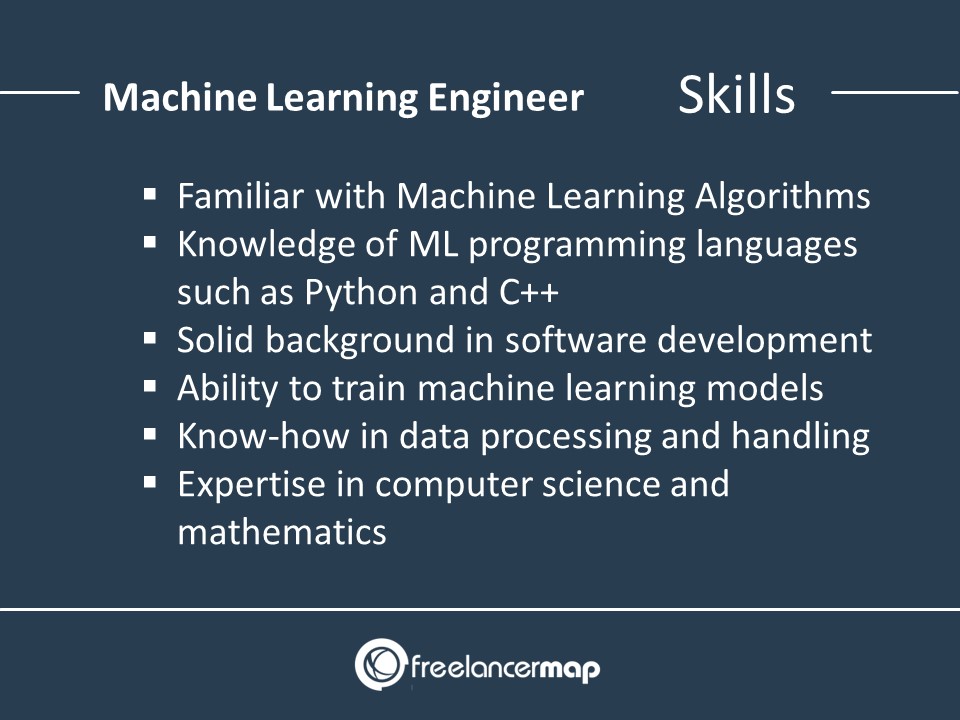All Categories
Featured
Table of Contents
- – Machine Learning Applied To Code Development C...
- – How What Do Machine Learning Engineers Actuall...
- – How Machine Learning Bootcamp: Build An Ml Po...
- – The Greatest Guide To What Is The Best Route ...
- – The Ultimate Guide To How Long Does It Take ...
- – Everything about Machine Learning Course - L...
- – Machine Learning For Developers Can Be Fun F...
Some people assume that that's dishonesty. Well, that's my entire job. If somebody else did it, I'm mosting likely to utilize what that person did. The lesson is putting that apart. I'm requiring myself to analyze the possible solutions. It's even more regarding consuming the content and attempting to apply those ideas and less regarding locating a collection that does the job or finding someone else that coded it.
Dig a little bit deeper in the mathematics at the beginning, just so I can construct that foundation. Santiago: Ultimately, lesson number seven. I do not believe that you have to recognize the nuts and screws of every formula before you use it.
I've been using semantic networks for the lengthiest time. I do have a sense of exactly how the slope descent works. I can not discuss it to you right currently. I would certainly need to go and examine back to really get a better intuition. That doesn't imply that I can not solve points utilizing neural networks? (29:05) Santiago: Trying to force people to assume "Well, you're not going to succeed unless you can explain each and every single detail of just how this functions." It returns to our arranging example I assume that's just bullshit recommendations.
As a designer, I've dealt with several, lots of systems and I have actually used numerous, numerous things that I do not comprehend the nuts and screws of how it functions, although I recognize the impact that they have. That's the final lesson on that particular thread. Alexey: The amusing point is when I think concerning all these libraries like Scikit-Learn the algorithms they use inside to execute, for instance, logistic regression or another thing, are not the like the formulas we study in artificial intelligence courses.
Machine Learning Applied To Code Development Can Be Fun For Anyone
Also if we tried to find out to obtain all these fundamentals of machine learning, at the end, the formulas that these libraries utilize are various. Santiago: Yeah, definitely. I think we need a lot more pragmatism in the market.

I usually speak to those that want to work in the industry that desire to have their influence there. I do not attempt to talk regarding that since I do not recognize.
Right there outside, in the industry, pragmatism goes a long means for sure. Santiago: There you go, yeah. Alexey: It is a great motivational speech.
How What Do Machine Learning Engineers Actually Do? can Save You Time, Stress, and Money.
Among things I intended to ask you. I am taking a note to discuss ending up being better at coding. However initially, allow's cover a number of things. (32:50) Alexey: Allow's begin with core devices and frameworks that you require to learn to actually transition. Let's state I am a software application designer.
I know Java. I recognize how to use Git. Perhaps I know Docker.
What are the core devices and structures that I require to learn to do this? (33:10) Santiago: Yeah, definitely. Excellent concern. I assume, number one, you ought to begin learning a little of Python. Since you already know Java, I don't think it's mosting likely to be a substantial shift for you.
Not due to the fact that Python coincides as Java, but in a week, you're gon na obtain a great deal of the differences there. You're gon na have the ability to make some progression. That's primary. (33:47) Santiago: Then you get certain core devices that are mosting likely to be used throughout your whole occupation.
How Machine Learning Bootcamp: Build An Ml Portfolio can Save You Time, Stress, and Money.
That's a library on Pandas for information manipulation. And Matplotlib and Seaborn and Plotly. Those 3, or among those three, for charting and presenting graphics. After that you obtain SciKit Learn for the collection of maker understanding formulas. Those are devices that you're going to have to be making use of. I do not advise simply going and finding out about them unexpectedly.
Take one of those courses that are going to begin introducing you to some problems and to some core ideas of equipment understanding. I don't remember the name, yet if you go to Kaggle, they have tutorials there for complimentary.
What's excellent about it is that the only need for you is to recognize Python. They're going to present an issue and inform you just how to make use of decision trees to resolve that certain issue. I think that procedure is very effective, since you go from no equipment finding out background, to understanding what the trouble is and why you can not solve it with what you know now, which is straight software program engineering methods.
The Greatest Guide To What Is The Best Route Of Becoming An Ai Engineer?
On the various other hand, ML engineers specialize in building and deploying artificial intelligence versions. They concentrate on training designs with information to make forecasts or automate tasks. While there is overlap, AI designers manage more varied AI applications, while ML designers have a narrower concentrate on maker understanding formulas and their useful execution.

Maker understanding engineers focus on creating and deploying equipment knowing models right into manufacturing systems. They deal with engineering, making sure versions are scalable, reliable, and integrated right into applications. On the various other hand, information scientists have a more comprehensive function that includes data collection, cleaning, exploration, and structure designs. They are usually in charge of drawing out insights and making data-driven decisions.
As organizations significantly take on AI and maker learning modern technologies, the need for knowledgeable experts grows. Device learning designers function on cutting-edge tasks, add to technology, and have affordable salaries.
ML is essentially different from typical software application development as it concentrates on mentor computer systems to gain from information, rather than programs explicit policies that are performed systematically. Uncertainty of end results: You are probably utilized to composing code with predictable outcomes, whether your function runs as soon as or a thousand times. In ML, nevertheless, the end results are less certain.

Pre-training and fine-tuning: Exactly how these designs are trained on large datasets and afterwards fine-tuned for certain tasks. Applications of LLMs: Such as text generation, sentiment evaluation and information search and access. Papers like "Interest is All You Need" by Vaswani et al., which introduced transformers. On-line tutorials and courses focusing on NLP and transformers, such as the Hugging Face course on transformers.
The Ultimate Guide To How Long Does It Take To Learn “Machine Learning” From A ...
The capacity to handle codebases, merge modifications, and resolve problems is equally as crucial in ML growth as it is in standard software application tasks. The skills created in debugging and testing software applications are highly transferable. While the context could alter from debugging application logic to identifying concerns in data processing or design training the underlying principles of methodical examination, hypothesis testing, and repetitive improvement coincide.
Artificial intelligence, at its core, is heavily dependent on stats and possibility theory. These are important for recognizing just how formulas gain from data, make predictions, and examine their performance. You should consider coming to be comfy with concepts like analytical value, distributions, hypothesis testing, and Bayesian thinking in order to design and interpret versions effectively.
For those curious about LLMs, a complete understanding of deep knowing architectures is useful. This consists of not just the technicians of semantic networks but likewise the architecture of certain models for various usage cases, like CNNs (Convolutional Neural Networks) for image processing and RNNs (Reoccurring Neural Networks) and transformers for sequential information and natural language processing.
You should understand these problems and learn strategies for identifying, mitigating, and interacting concerning predisposition in ML models. This includes the possible effect of automated choices and the ethical implications. Many versions, especially LLMs, call for substantial computational sources that are typically given by cloud platforms like AWS, Google Cloud, and Azure.
Structure these abilities will certainly not just facilitate an effective change into ML yet also guarantee that programmers can add properly and properly to the improvement of this vibrant area. Theory is important, however nothing beats hands-on experience. Beginning servicing tasks that allow you to apply what you've discovered in a sensible context.
Participate in competitors: Sign up with systems like Kaggle to get involved in NLP competitions. Build your tasks: Beginning with basic applications, such as a chatbot or a text summarization tool, and progressively increase intricacy. The field of ML and LLMs is quickly evolving, with new breakthroughs and modern technologies emerging consistently. Remaining updated with the most up to date research study and trends is essential.
Everything about Machine Learning Course - Learn Ml Course Online
Contribute to open-source projects or write blog articles about your knowing journey and projects. As you gain proficiency, begin looking for opportunities to include ML and LLMs into your job, or seek brand-new duties concentrated on these technologies.

Prospective use situations in interactive software program, such as referral systems and automated decision-making. Recognizing uncertainty, standard analytical steps, and chance distributions. Vectors, matrices, and their duty in ML algorithms. Error reduction techniques and gradient descent discussed just. Terms like model, dataset, attributes, labels, training, reasoning, and recognition. Data collection, preprocessing strategies, version training, assessment procedures, and release considerations.
Choice Trees and Random Woodlands: Intuitive and interpretable models. Matching problem kinds with suitable designs. Feedforward Networks, Convolutional Neural Networks (CNNs), Recurrent Neural Networks (RNNs).
Continual Integration/Continuous Deployment (CI/CD) for ML workflows. Design monitoring, versioning, and efficiency tracking. Finding and resolving adjustments in design efficiency over time.
Machine Learning For Developers Can Be Fun For Everyone

Course OverviewMachine discovering is the future for the future generation of software program specialists. This training course acts as an overview to equipment learning for software program designers. You'll be presented to three of one of the most pertinent parts of the AI/ML self-control; overseen understanding, neural networks, and deep knowing. You'll understand the differences between typical shows and equipment knowing by hands-on development in supervised knowing before building out complex distributed applications with semantic networks.
This course acts as an overview to equipment lear ... Program A lot more.
Table of Contents
- – Machine Learning Applied To Code Development C...
- – How What Do Machine Learning Engineers Actuall...
- – How Machine Learning Bootcamp: Build An Ml Po...
- – The Greatest Guide To What Is The Best Route ...
- – The Ultimate Guide To How Long Does It Take ...
- – Everything about Machine Learning Course - L...
- – Machine Learning For Developers Can Be Fun F...
Latest Posts
Mock Coding Interviews – How To Improve Your Performance
Why Communication Skills Matter In Software Engineering Interviews
Software Engineering Job Interview – Full Mock Interview Breakdown
More
Latest Posts
Mock Coding Interviews – How To Improve Your Performance
Why Communication Skills Matter In Software Engineering Interviews
Software Engineering Job Interview – Full Mock Interview Breakdown